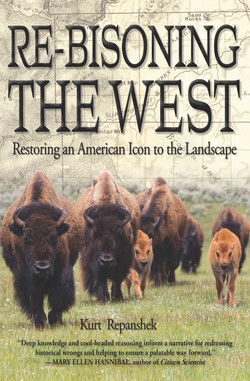Читать книгу Re-Bisoning the West - Kurt Repanshek - Страница 6
На сайте Литреса книга снята с продажи.
ОглавлениеACKNOWLEDGMENTS
What is it about bison that so intrigues and entrances? Their innate power? Their place on the landscape? Their ancientness?
It’s a question I hopefully answer in the following pages. And it’s one no doubt that Theodore Roosevelt, William Hornaday, Charles “Buffalo” Jones, Michel Pablo, Charles Pablo, and others in the late nineteenth and early twentieth centuries answered for themselves and used to drive their efforts to keep the species from going extinct. Those individuals, and their peers, deserve our thanks for the groundbreaking work they did in maintaining bison on the landscape.
There are many individuals who helped me in detailing how bison avoided extinction and examining how their numbers can be increased on the Great Plains. Dr. James Derr at Texas A&M University patiently helped me understand, at least in passing, bison genetics and cattle introgression. Dr. Glenn Plumb, formerly the chief wildlife biologist for the National Park Service and now the Bison Specialist Group Chair for the International Union for Conservation of Nature, explained the work the Department of the Interior and National Park Service are doing to increase the federal government’s conservation herds of bison, as did Greg Schroeder, the resource management chief at Wind Cave National Park.
I owe particular thanks to Philip Deloria, Harvard University’s tenured professor of Native American studies; Robbie Magnan of the Assiniboine and Sioux tribes at the Fort Peck Reservation; and Jason Baldes of the Eastern Shoshone Nation on the Wind River Indian Reservation for help in understanding what bison mean to native cultures. Damien Austin, superintendent of the nonprofit American Prairie Reserve in Montana, allowed me to tag along on a hunt for two bison that needed new radio collars, and endured my questions as we slowly drove across the prairie.
Staff and officials at the Montana Department of Livestock and Department of Fish, Wildlife, and Parks lent their perspectives of the Yellowstone bison issue, and Bill Bates, formerly of the Utah Division of Wildlife Resources, and Bob Mountain of the US Forest Service, happily discussed bison on the landscape and where new herds might (or might not) be located. Longtime colleague Angus Thuermer, Jr., at WyoFile, who collaborated on the initial series of bison articles that appeared on NationalParksTraveler.org in September 2017 and inspired this book, provided great reporting and writing then that have been incorporated into Re-Bisoning the West.
Special thanks to Kirsten Johanna Allen at Torrey House Press for seeing value in this project, and associate editor Anne Terashima for her keen edits, suggestions, and patience in trying to get a writer who grew up, professionally, with The Associated Press Stylebook, to adopt The Chicago Manual of Style.
An immeasurable amount of thanks goes to my wife, Marcelle Shoop, for enduring her husband’s writer’s blocks, long road trips in search of bison and their history, and struggles with telling a story more than 200,000 years in the making.
A great many others responded with helpful information and answers to my questions. A topic such as restoring bison on the Great Plains cannot be completely covered in a single book or paper, as evidenced by the many that have been produced on bison. The next chapter, of course, will involve what success is met in both growing the herds in general and, more specifically, preserving the genetic blueprint that makes bison such incredible animals.
Kurt Repanshek
Park City, Utah
2019
